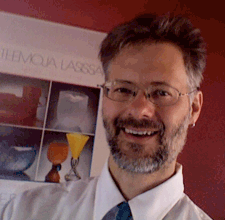Pilgrim Reindeer in Pisa, 1348
a free multimedia novel by
Thomas A. DuBois, University of Wisconsin-Madison
 |
Pilgrim Reindeer in Pisa, 1348 a free multimedia novel by Thomas A. DuBois, University of Wisconsin-Madison |
|
|
|
1. Part I Setting Out 13. Stockholm and Beyond [August 30, 1347]
This chapter is small in terms of the narrative at hand, but large in terms of the overall novel. In it, Nieiddash breeds, something that is going to be important if we are eventually to be able to account for a fresco showing someone milking a reindeer. As with dairy cattle or goats, without breeding, can be no milk. And reindeer breed at only one time during the year: the fall rut season. So Sweden turns out to be the locus of sex in my plot as in so many others....
Of course, as the epigram implies, I wanted to work here with the Song of Songs image of Jesus as a stag, uniting it with the figure of Nieiddash, our virgin cow. Meanwhile, on the human plane, Bávlos is thinking about the opposite sex as well, although he is about to fall in love with a very pious young woman for whom sexual relations are an utter impossibility. The story of the deer chase was a lot of fun to include in that it is an important part of Catharina's actual list of miracles. In the novel, the miracle takes on a new, although equally unlikely, logic: the fleeing deer is a domesticated animal who has been mistaken for wild game.
After all the narrative focus on the grandeur of Turku, I wanted to bypass Stockholm as much as possible. It had thousands of inhabitants as opposed to Turku's hundreds, and therefore would have been positively overwhelming for Bávlos. So I decided that the narrative—like the character—would just blot the whole experience out altogether. Of course, there was some enjoyment in skipping Stockholm, as Swedes tend to think of Stockholm as the very most important place in the entire country. To the medieval Swede, however, cities like the cathedral town of Linköping and (eventually) the monastic center of Vadstena were far more important, and Stockholm was just a mercantile center dominated by Hanseatic traders.